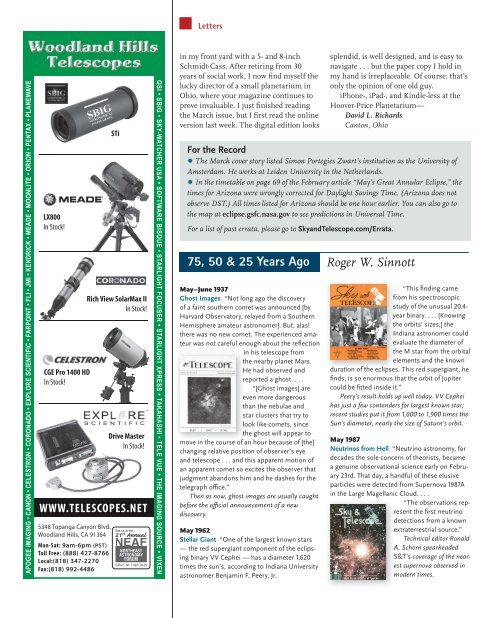Download this ebook as PDF - E-Book Library
Download this ebook as PDF - E-Book Library
Download this ebook as PDF - E-Book Library
You also want an ePaper? Increase the reach of your titles
YUMPU automatically turns print PDFs into web optimized ePapers that Google loves.
APOGEE IMAGING • CANON • CELESTRON • CORONADO • EXPLORE SCIENTIFIC • FARPOINT • FLI • JMI • KENDRICK • MEADE • MOONLITE • ORION • PENTAX • PLANEWAVE<br />
LX800<br />
In Stock!<br />
CGE Pro 1400 HD<br />
In Stock!<br />
5348 Topanga Canyon Blvd.<br />
Woodland Hills, CA 91364<br />
Mon-Sat: 9am-6pm (PST)<br />
Toll Free: (888) 427-8766<br />
Local:(818) 347-2270<br />
Fax:(818) 992-4486<br />
STi<br />
Rich View SolarMax II<br />
In Stock!<br />
Drive M<strong>as</strong>ter<br />
In Stock!<br />
WWW.TELESCOPES.NET<br />
See us at the:<br />
21 st Annual<br />
NEAF<br />
NORTHEAST<br />
ASTRONOMY<br />
FORUM<br />
Suffern, NY • April 28-29<br />
QSI • SBIG • SKY-WATCHER USA • SOFTWARE BISQUE • STARLIGHT FOCUSER • STARLIGHT XPRESS • TAKAHASHI • TELE VUE • THE IMAGING SOURCE • VIXEN<br />
Letters<br />
in my front yard with a 5- and 8-inch<br />
Schmidt-C<strong>as</strong>s. After retiring from 30<br />
years of social work, I now fi nd myself the<br />
lucky director of a small planetarium in<br />
Ohio, where your magazine continues to<br />
prove invaluable. I just fi nished reading<br />
the March issue, but I fi rst read the online<br />
version l<strong>as</strong>t week. The digital edition looks<br />
For the Record<br />
✹ The March cover story listed Simon Portegies Zwart’s institution <strong>as</strong> the University of<br />
Amsterdam. He works at Leiden University in the Netherlands.<br />
✹ In the timetable on page 69 of the February article “May’s Great Annular Eclipse,” the<br />
times for Arizona were wrongly corrected for Daylight Savings Time. (Arizona does not<br />
observe DST.) All times listed for Arizona should be one hour earlier. You can also go to<br />
the map at eclipse.gsfc.n<strong>as</strong>a.gov to see predictions in Universal Time.<br />
For a list of p<strong>as</strong>t errata, ple<strong>as</strong>e go to SkyandTelescope.com/Errata.<br />
75, 50 & 25 Years Ago Roger W. Sinnott<br />
May–June 1937<br />
Ghost Images “Not long ago the discovery<br />
of a faint southern comet w<strong>as</strong> announced [by<br />
Harvard Observatory, relayed from a Southern<br />
Hemisphere amateur <strong>as</strong>tronomer]. But, al<strong>as</strong>!<br />
there w<strong>as</strong> no new comet. The experienced amateur<br />
w<strong>as</strong> not careful enough about the refl ection<br />
in i his telescope from<br />
the t nearby planet Mars.<br />
He H had observed and<br />
reported r a ghost. . . .<br />
“[Ghost images] are<br />
even e more dangerous<br />
than t the nebulae and<br />
star s clusters that try to<br />
look l like comets, since<br />
the t ghost will appear to<br />
move in i the h course of fan<br />
hour because of [the]<br />
changing relative position of observer’s eye<br />
and telescope . . . and <strong>this</strong> apparent motion of<br />
an apparent comet so excites the observer that<br />
judgment abandons him and he d<strong>as</strong>hes for the<br />
telegraph offi ce.”<br />
Then <strong>as</strong> now, ghost images are usually caught<br />
before the offi cial announcement of a new<br />
discovery.<br />
May 1962<br />
Stellar Giant “One of the largest known stars<br />
— the red supergiant component of the eclipsing<br />
binary VV Cephei — h<strong>as</strong> a diameter 1,620<br />
times the sun’s, according to Indiana University<br />
<strong>as</strong>tronomer Benjamin F. Peery, Jr.<br />
splendid, is well designed, and is e<strong>as</strong>y to<br />
navigate . . . but the paper copy I hold in<br />
my hand is irreplaceable. Of course, that’s<br />
only the opinion of one old guy.<br />
iPhone-, iPad-, and Kindle-less at the<br />
Hoover-Price Planetarium—<br />
David L. Richards<br />
Canton, Ohio<br />
“This fi nding came<br />
from f his spectroscopic<br />
study s of the unusual 20.4year<br />
y binary. . . . [Knowing<br />
the t orbits’ sizes,] the<br />
Indiana I <strong>as</strong>tronomer could<br />
evaluate e the diameter of<br />
the t M star from the orbital<br />
elements e and the known<br />
duration of the eclipses. eclipse This red supergiant, he<br />
fi nds, is so enormous that the orbit of Jupiter<br />
could be fi tted inside it.”<br />
Peery’s result holds up well today. VV Cephei<br />
h<strong>as</strong> just a few contenders for largest known star;<br />
recent studies put it from 1,600 to 1,900 times the<br />
Sun’s diameter, nearly the size of Saturn’s orbit.<br />
May 1987<br />
Neutrinos from Hell “Neutrino <strong>as</strong>tronomy, for<br />
decades the sole concern of theorists, became<br />
a genuine observational science early on February<br />
23rd. That day, a handful of these elusive<br />
particles were detected from Supernova 1987A<br />
in the Large Magellanic Cloud. . . .<br />
“The observations represent<br />
r the fi rst neutrino<br />
detections d from a known<br />
extraterrestrial e<br />
source.”<br />
Technical editor Ronald<br />
A. A Schorn spearheaded<br />
S&T’s S coverage of the nearest<br />
e supernova observed in<br />
modern m times.


